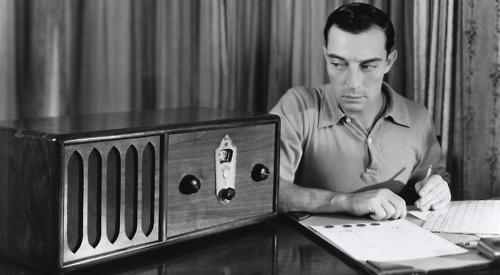
The Crack of the Mini-Bat: A broadcaster’s tribute to baseball’s past
In addition to his contributions to The Good Point, Jesse Goldberg-Strassler is the full-time broadcaster of the Toronto Blue Jay-affiliate Lansing Lugnuts, of the Class A Midwest League. What follows is a personal account of what has become a yearly tradition in his broadcasting booth; a tribute to the radio giants of baseball’s past.
In August of every year, I broadcast a baseball game without watching it.
The game is real, the score is accurate… and the sounds of the game are a pair of red and black mini-bats cracking together; a discarded batting practice ball slamming into a poorly-oiled, well-used black Rawlings glove; and maybe, if I get it right this year, authentic-sounding pre-taped crowd chatter.
This year, my broadcast was scheduled for August 23, Dayton Dragons at Lansing Lugnuts. I’ll sit in the open press box area, my sound materials and a computer in front of me, receiving messages from No. 2 broadcaster Kyler Ludlow. In the middle innings, Kyler and I switched off, and then switched again for the last third; this has been our play-by-play arrangement for the entire season.
The messages will read as simply as “strike” or “flyout to center,” requiring flourishes of added originality in the re-creating. Think of the gray area that calling a “strike” presents: I could conjure a long fly barely pushed foul, or maybe a questionable slider barely grasping at the outside corner. For a fan attempting to watch and listen to the game at the same time, it’s as if their faithful broadcaster is watching from the Twilight Zone – but my results always match the box score.
Creating a game out of thin air is draining. Every year I fall well behind of the game’s true pace, trying desperately to keep an even rhythm while the messages amass on the computer screen. It feels ridiculous, too, talking nearly nonstop for hour upon hour while surrounded by laughing/gawking co-workers rather than the calm sight of the field illuminated by stadium lights.
[php snippet=1]
Why re-create a ballgame?
There are two reasons, one traditional and one personal. First, the traditional reason.
Baseball loves and celebrates its history with all the ear-to-ear smiling sentimentalism of a 20-something white-collar worker listening to an old mixtape from junior high. Glory years are glorified. Legends are revered. Tributes are aplenty, whether in retired numbers, uniform patches, or high stirrups/socks pulled up to the knees.
Why not, then, pay tribute to the broadcasters who came before me? Beginning with Harold Arlin’s August 5, 1921, Phillies/Pirates broadcast for KDKA in Pittsburgh, baseball broadcasters have brought the game to life for all of those unable to attend the contests in person. Due to budget and technology constraints that prevented the broadcasters from traveling on the road, it became commonplace for each team’s voice to re-create games from the wire reports.
The best way to pay tribute to the legends of baseball broadcasting – Red Barber, Ernie Harwell, Mel Allen and their ilk – is to call a game in the very style in which they called it; albeit replacing the telegraph with modern computer messaging.
Now the other reason.
While working as the No. 3 broadcaster/studio host for the independent Brockton Rox in 2005, I was assigned (along with No. 2 broadcaster Matt Meola) to perform a game re-creation by team president Jim Lucas. No. 1 broadcaster Dave Raymond, now the voice of the Houston Astros, received the night off. To sum up the evening: Our crowd noise was too loud. Matt was strong. I may have been slightly less strong – in the same sense that Gaylord Perry slightly moistened baseballs, J.P. Ricciardi made slightly incorrect personnel decisions, and Ty Cobb was slightly short of a Good Samaritan. Still, mission accomplished. Matt and I had re-created a game. We were wiped and exhilarated.
Skip ahead to August of 2008 now. I’m now the No. 1 internet-only broadcaster for the independent Windy City ThunderBolts, assisted by Nick Kovatch. An enormous storm rolled the Chicagoland area, knocking out all wireless internet in the press box. If Nick and I wanted to broadcast the game to all of the Bolts’ waiting fans, family, and friends, we would need to do so from the only area at the ballpark that still had internet: inside the front office. A second game re-creation was in order, and so we did just that.
That may have well been the end of the story, except that talented left-hander Isaac Hess chose to twirl the first no-hitter in ThunderBolts franchise history that night, mesmerizing the visiting Midwest Sliders.
It was the first no-hitter I ever broadcasted, and I never saw it.
From then onward, I have made the choice to add the game re-creation as a personal tradition, annually putting forth the effort on an otherwise mundane August evening iIt must be August every year, you see, because of Harold Arlin and Isaac Hess). The results have been alternately amusing, enthralling, and comical. Every now and then, I clumsily drop the mini-bats while transferring between them and the ball/glove, requiring the frantic invention of pitching visit to the mound or an argument with an umpire while I go scrambling after my sound effects.
I’m never sure how well the effect comes across with our listeners, whether they appreciate the nod to the broadcasters of yore or sigh at the artificial sounds of an inaccurately-described game lagging an inning behind, but it has remained meaningful to me.
A baseball radio broadcast is at its heart a true theater of the mind. A broadcaster who cannot see the game is reminded that his listeners cannot see the game, either. There is no broadcast without a game, and there is no broadcast without listeners.
I have my mini-bats ready, no pine tar necessary.
[php snippet=1]

